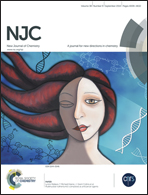Synthesis and structural characterization of 1-arylimidazole-2-thiones and N,N′-aryldiethoxyethylthioureas with electronically diverse substituents: a manifold of hydrogen bonding networks†
Abstract
The 1-arylimidazole-2-thiones, (HmimAr) [Ar = 3,4,5-C6H2(OMe)3, 2,4-C6H3(NO2)(OMe), 2,4,6-C6H2Cl3 and 3,5-C6H3(CF3)2], which feature electronically diverse substituents, may be obtained via acid-catalyzed ring closure of the corresponding N,N′-aryldiethoxyethylthiourea derivatives, ArN(H)C(S)N(H)CH2CH(OEt)2, (H2detuAr), which in turn are obtained via treatment of aminoacetaldehyde diethyl acetal, H2NCH2CH(OEt)2, with the respective arylisothiocyanates (ArNCS). The molecular structures of all of the above N,N′-aryldiethoxyethylthioureas and 1-arylimidazole-2-thiones have been determined by X-ray diffraction, thereby demonstrating that the substituents have a profound effect on the crystal structures. For example, each of the N,N′-aryldiethoxyethylthiourea derivatives adopts a different hydrogen bonding pattern. Specifically, the hydrogen-bonding network in (i) H2detuArCl3 consists of chains of 9-membered rings, with an [R22(9)] motif, that feature one N–H⋯O and one N–H⋯S interaction, (ii) H2detuArOMe,NO2 consists of chains of 6-membered rings, with an [R12(6)] motif, that feature two head-to-tail N–H⋯S interactions, (iii) H2detuAr(CF3)2 consists of a dimer that features two pairs of N–H⋯O interactions, of which each pair is a component of an 8-membered ring with an [R22(8)] motif, and (iv) H2detuAr(OMe)3 consists of a chain of head-to-head dimeric rings with a basic [R22(16)] motif, a notable feature of which is that sulfur does not play a role as a hydrogen bond acceptor. Each of the 1-arylimidazole-2-thiones exists as a “head-to-head” hydrogen-bonded dimer in the solid state, with an [R22(8)] motif. However, while the hydrogen-bonded motifs for HmimArCl3 and HmimAr(OMe)3 are planar, those for HmimAr(CF3)2 and HmimArOMe,NO2 are extremely puckered, with fold angles of 24.2° (mean value) and 45.7°, respectively.


 Please wait while we load your content...
Please wait while we load your content...